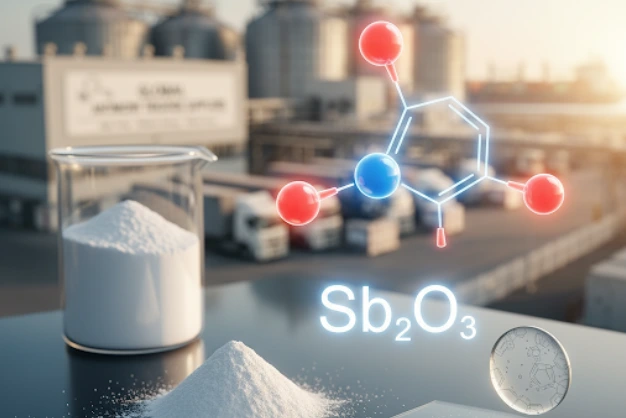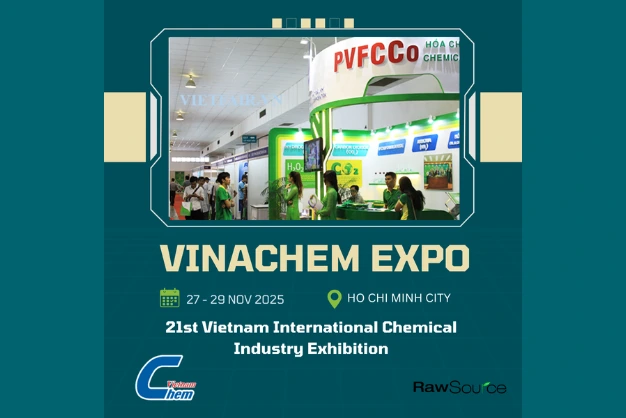Beyond traditional supplier evaluation criteria, understanding the molecular structure, polymorphic forms, production pathways, and technical properties of antimony trioxide (Sb₂O₃) is essential.
This knowledge allows buyers to separate commodity-grade powders from high-purity, application-specific materials — ensuring procurement managers can identify reliable antimony trioxide suppliers, validate documentation such as SDS, TDS, and CAS numbers, and ultimately secure consistent, high-performance Sb₂O₃ for their industry needs.
Antimony trioxide structure
- Cubic (Senarmontite): Stable at ambient conditions, the primary commercial product.
- Orthorhombic (Valentinite): Forms at elevated temperatures, with reversion to cubic upon cooling.
Production Pathways
- Direct Oxidation of Antimony Metal:
4Sb+3O2→2Sb2O3
This route yields a fine particulate oxide that is typically classified and milled to customer-specific particle size distributions — information reputable antimony trioxide suppliers will disclose in their technical datasheets. - Roasting of Stibnite (Sb₂S₃) Ore:
2Sb2S3+9O2→2Sb2O3+6SO2
Requires SO₂ scrubbing to comply with emissions standards.
Antimony trioxide Properties & Structure
- Antimony trioxide formula: Sb₂O₃
- Antimony trioxide molecular weight: 291.52 g/mol
- Antimony trioxide density: ~5.2 g/cm³ (true density); bulk density varies between 0.9–1.8 g/cm³ depending on processing and particle morphology.
- Melting Point: ~656 °C
- Sublimation Temperature: ~1425 °C
- Solubility: Insoluble in water; soluble in acids and alkalis
- Particle Size: Determines effectiveness in flame-retardant and catalytic systems
Antimony Trioxide SDS
Every purchase of Sb₂O₃ must be accompanied by an antimony trioxide SDS (Safety Data Sheet). This document outlines the compound’s hazard classification, recommended personal protective equipment, safe storage, transport requirements, and emergency measures. Modern SDS formats comply with GHS standards and replace the older MSDS terminology.
- Identification: product name, antimony trioxide CAS No, supplier details
- Hazards: classification as a suspected carcinogen
- First-aid measures: response to inhalation or skin contact
- Handling and storage: ventilation, PPE, and packaging
- Regulatory information: alignment with OSHA, REACH, and EU directives
Antimony Trioxide CAS Number
Referencing antimony trioxide with its CAS number (1309-64-4) ensures precision, eliminates ambiguity, and adds credibility across procurement, regulatory, and research contexts. By citing 1309-64-4, buyers, regulators, and researchers can confirm they are referencing the correct oxide and not another antimony compound such as pentoxide (Sb₂O₅) or trichloride (SbCl₃).
Antimony Trioxide Fire Retardant
Role as Fire Retardant
- Sb₂O₃ is widely used as an antimony trioxide fire retardant in plastics, textiles, coatings, and rubber.
- It does not act as a flame retardant independently but serves as a synergist with halogenated compounds.
- Its use enables lower loading levels of halogenated additives while still achieving compliance with fire safety standards.
Flame Retardant Mechanism
- The antimony trioxide flame retardant mechanism occurs under heat exposure.
- Sb₂O₃ reacts with halogen donors (chlorine/bromine compounds) to form volatile antimony halides.
- These migrate into the vapor phase of the burning material.
- Antimony halides quench free radicals in the flame, disrupting combustion chain reactions.
- This reduces flame spread, slows ignition, and enhances overall fire resistance.
Antimony trioxide Trade, Documentation, and Market Data
Antimony trioxide HS code
- HS Code: 28258000
- Defines Sb₂O₃ under international tariff schedules.
- Critical for customs clearance, duty calculation, and regulatory alignment across jurisdictions.
- Misclassification risks penalties, shipment delays, and compliance breaches.
Antimony trioxide MSDS (Material Safety Data Sheet)
- Classification: IARC Group 2B (possible carcinogen); EU CLP H351 (suspected of causing cancer).
- Exposure limits:
- OSHA PEL: 0.5 mg/m³ (as Sb, TWA 8h)
- ACGIH TLV: 0.5 mg/m³ (as Sb, TWA)
- Transport classifications:
- UN#: Not classified as dangerous goods under ADR/IMDG/IATA, but requires Sb content declaration.
- Critical sections:
- Section 8: PPE requirements (respiratory protection, HEPA filtration in bagging areas).
- Section 11: Chronic inhalation data from occupational exposure studies.
Antimony trioxide TDS (Technical Data Sheet)
Typical Technical Ranges for Industrial Grades
Sb₂O₃ Content (≥ 99.5 wt.% – polyester catalyst grade): Ensures high purity and consistent catalytic performance.
Trace Elements (Pb < 50 ppm, As < 50 ppm, Fe < 30 ppm – critical for PET): Low impurities safeguard product safety and optical clarity.
Particle Size (D50 = 0.3–1.2 µm; finer < 0.2 µm for PET): Controls dispersion in flame-retardant fillers and optimizes reactivity in PET catalysts.
BET Surface Area (2–6 m²/g): Higher surface area improves polymerization efficiency and reactivity.
Bulk Density (0.9–1.8 g/cm³): Influences dosing, storage, and processing in industrial applications.
Optical Whiteness Index (> 96 – critical for transparent PET): Maintains product brightness and clarity in end-use applications.
Antimony Trioxide Price Chart
Scope: Tracks Sb₂O₃ benchmark values across China, EU, and US markets.
Key Price Drivers:
Primary antimony feedstock supply (China, Russia, Bolivia).
Energy-intensive roasting/oxidation costs.
Environmental regulations on SO₂/Sb emissions.
Application in Procurement: Pricing data supports contract negotiation, inventory planning, and hedging against supply risk.
Sourcing and Procurement Considerations
Antimony trioxide manufacturing plant
- Industrial production facilities determine not only output volume but also product quality.
- A modern plant includes ore roasting or metal oxidation lines, refining systems, micronization units, and strict SO₂ emission controls.
- Auditing a supplier’s manufacturing plant provides assurance about sustainability, process stability, and technical transparency.
- Industrial production facilities determine not only output volume but also product quality.
Antimony trioxide powder
- The most common commercial form of Sb₂O₃ is a fine white powder.
- Particle size distribution directly affects performance in flame-retardant systems, catalysts, and specialty glasses.
- Grades range from standard commodity powders to micronized or pelletized forms tailored to specific applications.
- The most common commercial form of Sb₂O₃ is a fine white powder.
Buy antimony trioxide
- Organizations looking to purchase Sb₂O₃ should consider more than just price.
- Best practice is to review supplier documentation (SDS, MSDS, TDS), verify CAS No (1309-64-4) and HS code (2825.80), and request batch-specific certificates of analysis.
- Procurement teams can buy antimony trioxide directly from producers or through regional distributors who maintain local stock, such as those in the USA.
- Organizations looking to purchase Sb₂O₃ should consider more than just price.
Conclusion
Frequently Asked Questions (FAQs) on Antimony Trioxide
Physicochemical Properties
What are the key properties of antimony trioxide?
Sb₂O₃ has a true density of ~5.2 g/cm³, bulk density between 0.9–1.8 g/cm³, a melting point of ~656 °C, and sublimates at ~1425 °C. It is insoluble in water but dissolves in acids and alkalis.
What is the difference between antimony pentoxide (Sb₂O₅) and antimony trioxide (Sb₂O₃)?
- Sb₂O₃: Used as a flame-retardant synergist and catalyst
- Sb₂O₅: Higher oxidation state, applied in ceramics, electrochemical systems, and distinct flame-retardant formulations
Applications
How is antimony trioxide used as a fire retardant?
Functions as a synergist with halogenated compounds, lowering ignition temperature, reducing flame spread, and minimizing smoke generation.
What is the flame-retardant mechanism of antimony trioxide?
At elevated temperatures, Sb₂O₃ reacts with halogens to form antimony halides, which quench free radicals in the flame zone, suppressing combustion.
Can antimony trioxide be used as a catalyst?
Yes, it is widely applied in:
- Polymerization processes
- Glass manufacturing
- Specialty chemical synthesis
Manufacturing & Supply Chain
How is antimony trioxide manufactured?
Produced by:
- Oxidizing metallic antimony
- Roasting stibnite ore (Sb₂S₃) under controlled emissions
- Further refining and micronization for high-purity grades
Technical & Process Queries
How is antimony trioxide extracted?
By roasting stibnite ore (Sb₂S₃) or oxidizing metallic antimony.
How is antimony trichloride (SbCl₃) converted to Sb₂O₃?
Via hydrolysis or oxidation reactions.
How is antimony trioxide classified?
Classified as hazardous:
- IARC Group 2B – Suspected carcinogen
- Requires compliance with OSHA, REACH, EU, and global safety regulations





